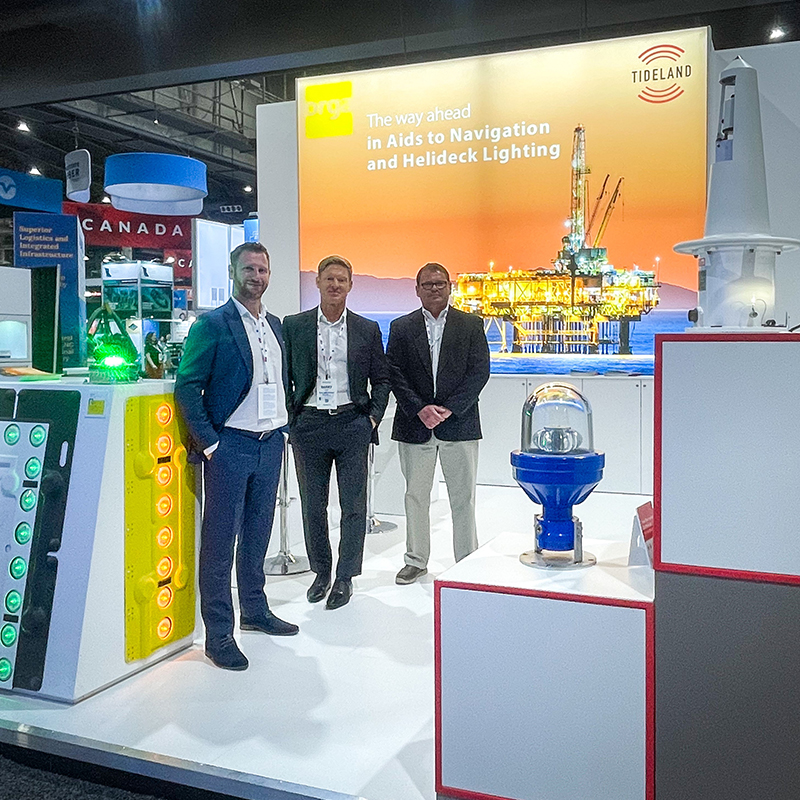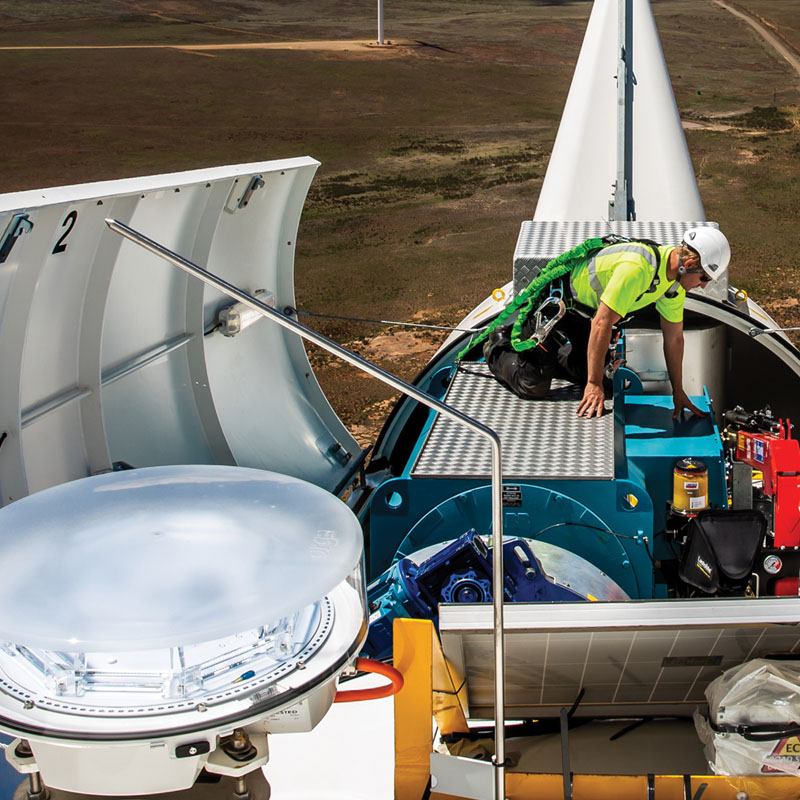Smart obstacle lighting solutions for wind turbines
Recently published in the magazines EU Infrastructure and NG Power & EU Energy.
As project developers widen their search for suitable wind farm sites, and deploy larger and larger capacity wind turbines the industry is presented with some unexpected new challenges. One of the areas to have experienced significant interest over the past five years is that of aviation safety and the optimum obstacle marking of wind turbines.
There are well established international standards and recommended practices relating to aviation safety that were first adopted at the Convention of International Civil Aviation, held in Chicago in 1944. The standards and recommended practices that address the subject of flight safety in the context of how significant obstacles that present an obstruction hazard to aircraft are to be marked were first adopted in 1951. The purpose of the marking of such structures is to “reduce the hazards to aircraft (in flight) by indicating the presence of obstacles” (International Civil Aviation Organisation, Annex 14 to the Convention of International Civil Aviation, Volume 1 Aerodrome Design and Operations, Chapter 6).
Significant obstacles may be marked in a number of defined ways to provide pilots of aircraft with a visual indication of the location, height and scope of an obstruction under both day time and night time operation conditions. In the context of wind turbines these significant obstacles are typically considered by the aviation safety governing bodies to be turbines that have a vertical blade tip height in excess of 100m above ground or sea level, although as each country may adopt and adapt the standards in their own way there are some national variations. Recent developments in large turbine technology means that wind farms will soon be deploying turbines with vertical blade tip heights as high as 200m above ground level. At these heights wind turbines present a significant hazard as many more aircraft are allowed to fly above 150m than below, where operations are typically limited to safetyrelated services and military operations.
Whilst day time marking of some obstacles may be achieved through the use of colour markings, of flags, or of obstacle lights; night time marking can only be achieved through the use of obstacle lights.
The standards and recommended practices further define the characteristics of the type of lights that may be used to mark obstacles, and the location of lights on such obstacles. The characteristics of the lights has been defined to ensure that pilots of aircraft are able to recognise the presence of obstacles under worst case visual flying conditions.
There are hundreds of thousands of installations worldwide that use obstacle lights to mark structures that may present a hazard to safe air traffic movement. The vast majority of the typical marked sites have historically involved individual isolated structures such as telecommunication towers, TV and radio broadcast towers, power line transmission towers, chimneys and tall buildings. There were generally few planning or environmental issues associated with the use of obstruction lights on these sites.
However the development of large wind farms, with potentially hundreds of structures in one area that may require obstacle lights for safety marking, creates scenarios not imagined when the standards and recommended practise were defined.
Whilst it is widely recognised that the obstacle lights serve a vital safety function to provide a visual indication to pilots of the presence of hazardous structures, it is not uncommon for project developers and installation operators to encounter problems regarding local planning acceptance due to the perceived visual impact of the obstruction lights.
Designers and manufacturers of obstruction lights have been closely following this topic and have developed new products that combine state of the art optical design and light sources with advanced control technologies into new products that minimise the intrusive impact of the required obstacle lights, whilst maintaining the effectiveness of the lights in providing safety marking information to pilots of aircraft.
Amongst the potential beneficial developments now offered by the latest obstacle lighting products are:
- Self synchronised lights to eliminate the otherwise visually random and distracting flash pattern of a multiple structure installation. In addition to improving safety by providing pilots with a single visual marking of the entirety of the wind farm this will also normally allow for a reduced number of lights at the installation as not all turbines then need to be marked.
- Solid state controllable LED light sources that replace strobe based ones and that allows for fine tuning of the properties of the flash character and so to offer an obstacle light with a less aggressive flash character.
- Lights with advanced power control designs to ensure that the obstacle light has a stabilised light output so that the operating intensity of LED based lights does not exceed the requirements of the standards at low temperatures where LEDs operate more efficiently.
- Lights with a very narrow beam profile to minimise the amount of stray light within the requirements of the standards.
- Adaptive intensity control so that the obstacle lights can be set to operate at the optimum intensity for the real time ambient visibility conditions. The light is then only as bright as it needs to be to meet the pilot’s acquisition distance rather than always operating at the “worst case” setting. This typically results at lights that are controlled to operate at 10% or 30% of the full intensity for the majority of the time.
Third party systems that enables integration of the obstacle light system with a “smart light switch” to turn the lights on only when they are needed when there is air traffic in the immediate vicinity of the site, rather than having them on all the time “just iRecently published in the magazines EU Infrastructure and NG Power & EU Energy.
As project developers widen their search for suitable wind farm sites, and deploy larger and larger capacity wind turbines the industry is presented with some unexpected new challenges. One of the areas to have experienced significant interest over the past five years is that of aviation safety and the optimum obstacle marking of wind turbines.
There are well established international standards and recommended practices relating to aviation safety that were first adopted at the Convention of International Civil Aviation, held in Chicago in 1944. The standards and recommended practices that address the subject of flight safety in the context of how significant obstacles that present an obstruction hazard to aircraft are to be marked were first adopted in 1951. The purpose of the marking of such structures is to “reduce the hazards to aircraft (in flight) by indicating the presence of obstacles” (International Civil Aviation Organisation, Annex 14 to the Convention of International Civil Aviation, Volume 1 Aerodrome Design and Operations, Chapter 6).
Significant obstacles may be marked in a number of defined ways to provide pilots of aircraft with a visual indication of the location, height and scope of an obstruction under both day time and night time operation conditions. In the context of wind turbines these significant obstacles are typically considered by the aviation safety governing bodies to be turbines that have a vertical blade tip height in excess of 100m above ground or sea level, although as each country may adopt and adapt the standards in their own way there are some national variations. Recent developments in large turbine technology means that wind farms will soon be deploying turbines with vertical blade tip heights as high as 200m above ground level. At these heights wind turbines present a significant hazard as many more aircraft are allowed to fly above 150m than below, where operations are typically limited to safetyrelated services and military operations.
Whilst day time marking of some obstacles may be achieved through the use of colour markings, of flags, or of obstacle lights; night time marking can only be achieved through the use of obstacle lights.
The standards and recommended practices further define the characteristics of the type of lights that may be used to mark obstacles, and the location of lights on such obstacles. The characteristics of the lights has been defined to ensure that pilots of aircraft are able to recognise the presence of obstacles under worst case visual flying conditions.
There are hundreds of thousands of installations worldwide that use obstacle lights to mark structures that may present a hazard to safe air traffic movement. The vast majority of the typical marked sites have historically involved individual isolated structures such as telecommunication towers, TV and radio broadcast towers, power line transmission towers, chimneys and tall buildings. There were generally few planning or environmental issues associated with the use of obstruction lights on these sites.
However the development of large wind farms, with potentially hundreds of structures in one area that may require obstacle lights for safety marking, creates scenarios not imagined when the standards and recommended practise were defined.
Whilst it is widely recognised that the obstacle lights serve a vital safety function to provide a visual indication to pilots of the presence of hazardous structures, it is not uncommon for project developers and installation operators to encounter problems regarding local planning acceptance due to the perceived visual impact of the obstruction lights.
Designers and manufacturers of obstruction lights have been closely following this topic and have developed new products that combine state of the art optical design and light sources with advanced control technologies into new products that minimise the intrusive impact of the required obstacle lights, whilst maintaining the effectiveness of the lights in providing safety marking information to pilots of aircraft.
Amongst the potential beneficial developments now offered by the latest obstacle lighting products are:
Self synchronised lights to eliminate the otherwise visually random and distracting flash pattern of a multiple structure installation. In addition to improving safety by providing pilots with a single visual marking of the entirety of the wind farm this will also normally allow for a reduced number of lights at the installation as not all turbines then need to be marked.
Solid state controllable LED light sources that replace strobe based ones and that allows for fine tuning of the properties of the flash character and so to offer an obstacle light with a less aggressive flash character.
Lights with advanced power control designs to ensure that the obstacle light has a stabilised light output so that the operating intensity of LED based lights does not exceed the requirements of the standards at low temperatures where LEDs operate more efficiently.
Lights with a very narrow beam profile to minimise the amount of stray light within the requirements of the standards.
Adaptive intensity control so that the obstacle lights can be set to operate at the optimum intensity for the real time ambient visibility conditions. The light is then only as bright as it needs to be to meet the pilot’s acquisition distance rather than always operating at the “worst case” setting. This typically results at lights that are controlled to operate at 10% or 30% of the full intensity for the majority of the time.
Third party systems that enables integration of the obstacle light system with a “smart light switch” to turn the lights on only when they are needed when there is air traffic in the immediate vicinity of the site, rather than having them on all the time “just in case”.
For more information, please contact
Matthieu Scheffers, Regional Sales Manager, Orga Aviation BV
T +31 10 208 5511
E m.scheffers@orga.nl
For more information, please also see www.orga-aviation.nl



